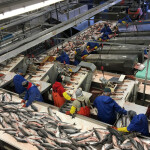With sustainability over-hanging all European discussions on fish stocks, French scientists are setting electronic tags in motion for bass in a bid to better understand migration patterns.
Researchers at the state agency Ifremer are responsible for judging stock levels and working with the European Union. But, according to the agency’s scientists, there’s a “deficit of knowledge” on sea bass, particularly the structure of populations.
“The objective of our new research is to acquire behavioral information that will allow us to better understand species migration and exchanges between populations,” said the agency last week.
In collaboration with the Iroise national marine park, scientists have placed an electronic tag in the stomach of about 100 bass. The electronic gadget allows researchers to record, in real time, the temperature and depth of the water, notably movement between the English Channel and the Bay of Biscay.
Fishermen and wholesalers can easily spot the tagged fish because the bass also have a 1-centimeter long red tag on their dorsal fin.
Ifremer and Iroise have called on seafood professionals, from fishermen to auction personnel, to aid the project by taking any caught and marked fish to the scientists’ laboratories. For each whole bass returned to researchers with the external and abdominal tag in place, fishermen will receive EUR 100 and the possibility of winning another EUR 1,000.
“The information we need at the lab requires whole fish either fresh or frozen, not gutted, plus all details of their capture; the date, geographical position, and the fishing motor,” said the scientists, stressing that recuperation of bass for the experiment is actually reliant on stakeholders in the fishing industry.
Data supplied by French state agency FranceAgiMer suggests that the market for fresh bass in France has remained steady over the past five years. In 2008, the French consumed 4,685 metric tons of fresh bass, compared to 4,830 metric tons in 2005. By comparison, in 2008 the French ate a total of 138,116 metric tons of fresh fish; salmon represented the lion’s share (27,968 metric tons).
All Environment & Sustainability stories >




